How to grow potatoes in a bag – everything you need to know
Learning how to grow potatoes in a bag will have you harvesting delicious vegetables in no time
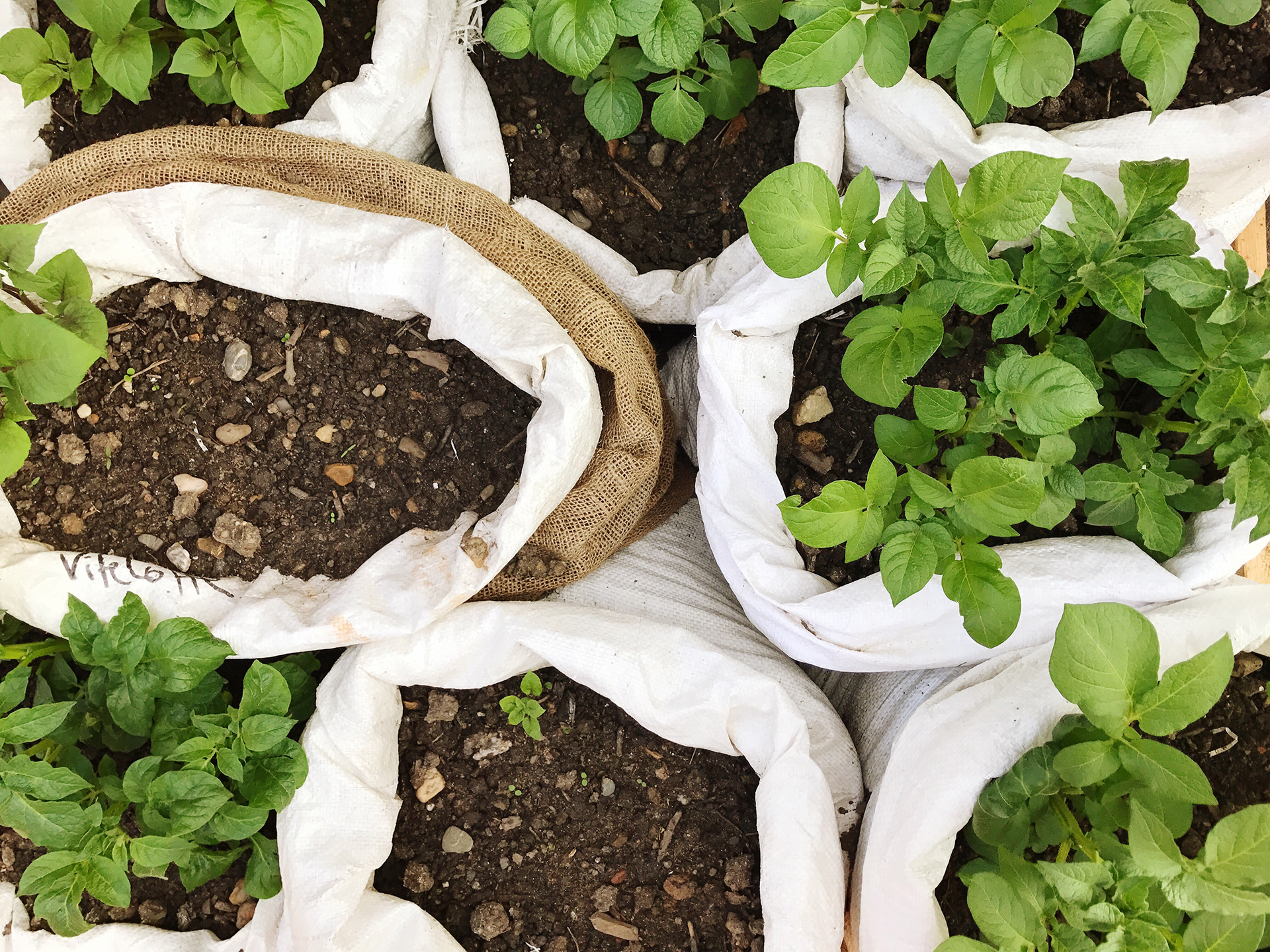

Learning how to use a grow bag will open up a whole new world of gardening potential. An extremely easy vegetable to grow, potatoes offer a high-yield for very low output - they're a great choice if you're new to growing your own vegetables. Find out how to grow potatoes with our step-by-step guide – perfect for your vegetable garden ideas.
When considering how to use grow bags, potatoes are also best grown in containers due to their propensity to spread into all the soil available to their tuberous roots. They are also difficult to harvest in raised beds or borders, often leaving behind unwanted 'volunteers' that will start their own unwanted potato plant the following year.
Therefore, knowing how to grow potatoes in a bag offers one of the best options for growing your own, both in terms of ease of harvest and versatility. 'You can even have potatoes in a tiny rented plot. Grow them in a potato bag or sack and you’ll be able to move house without unearthing your sack of spuds,' says Amateur Gardening magazine's Tamsin Westhorpe.
How to grow potatoes in a bag – preparation
There are three things that you will need before starting to learn how to grow potatoes in a bag for your kitchen garden. These are: chitted seed potatoes; compost; and a bag.
Chitting potatoes helps to accelerate the growth of your potatoes. Stand the seed potatoes in egg boxes and place in a light and cool, but frost-free, place. Light is vital so a windowsill in a porch or outside in a glass greenhouse are an ideal place to place your potatoes to chit.
'Keep an eye on your potatoes whilst they chit and wait for strong, short green shoots to appear (4-6 weeks) about 2-3cms long from the eyes of each tuber,' says plantswoman Sarah Raven,
'If you want to maximize the size of your potatoes, rub off all but three or four of the shoots at the top end of the tuber before planting out. If you leave all the shoots intact, you’ll end up with lots of small potatoes.' Once you've got shoots, your seed potatoes are ready to plant out.
Design expertise in your inbox – from inspiring decorating ideas and beautiful celebrity homes to practical gardening advice and shopping round-ups.
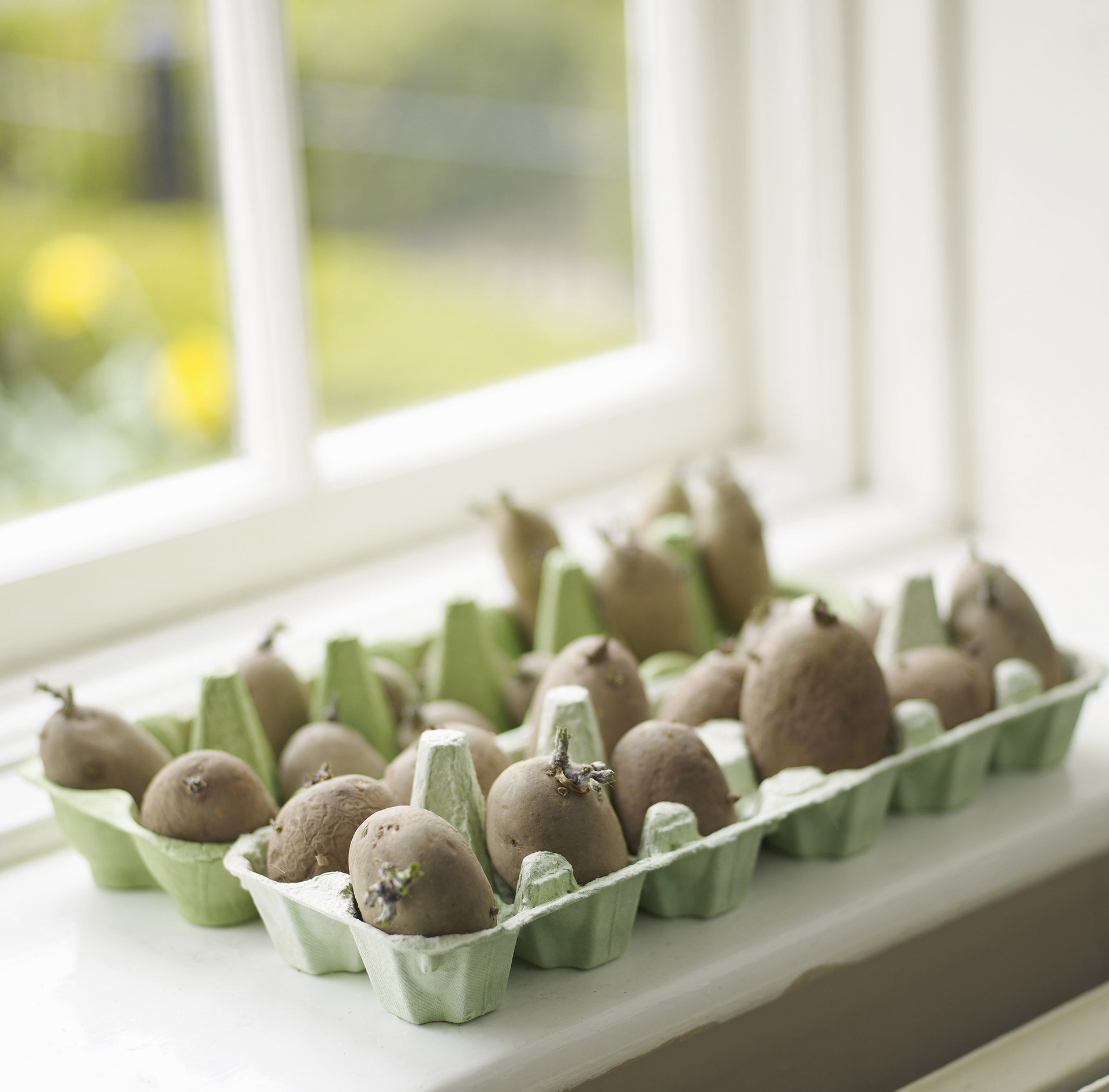
If you're working out how to grow potatoes in a bag then you also need to think about the soil. Potatoes grow best in 'well-drained, light, deep, loose soil, high in organic matter,' says the experts at Cornell University. Potato plants also 'perform best in acid soil with pH 4.8 - 5.5'. So, by growing your potatoes in a bag, rather than a raised bed or in the garden, you can curate the perfect soil conditions for the potatoes.
The final consideration for learning how to grow potatoes in a bag, is the bag itself.
'The important thing is that the bags need good drainage, so with re-used plastic bags do ensure that you make lots of extra holes in the bottom,' advises Bob Flowerdew in Amateur Gardening Magazine. 'Nearly as important is that the sides must exclude light – black bags are better. Hold them up to the light, and if any comes through then try doubling up or line the bags with several sheets of newspaper.'
Alternatively, purchase a dedicated potato bag that will be designed for the task. Some varieties even have a flap that helps you check on your potatoes while they're growing.
Traditional DIY method for growing potatoes in a bag
- Opt for a large sturdy rubble bag, hessian or jute sack, or a specific potato bag – around 8 to 10 gallons are the most popular sizes. Prick a few small holes into the bottom to prevent the bag becoming waterlogged.
- Fill the bottom of the bag with about five inches of compost.
- Roll the sides of the bag down to the level of the compost so that it stands by itself.
- Plant three or four chitted potatoes – roots facing down - into the compost and then cover with a few inches of additional compost – unrolling the first folds of the bag if needed.
- Place in a light, bright, frost-free position and water well.
- When the potato plant starts to grow green shoots , unfold the edges of the bag until it reaches the top of the shoots and then cover with soil.
- Continue to do this every time shoots are visible or until the bag is full.
- Watering is vital but only water when the top few centimetres of soil feel dry to the touch. 'If the tubers dry out while they are developing, they won’t develop into potatoes, resulting in a smaller harvest,' advises Deborah Miuccio, product research and testing coordinator at Gardener’s Supply Company. On the other hand, overwatering can cause the tubers to rot which will also reduce the quantity and quality of your harvest.
- When there is no more bag to unroll, then let the shoots grow.
- Once the leaves and stem have started to die back, harvest potatoes by cutting through the plastic bag or tipping out jute, hessian or fabric sacks on a sheet of tarp and collect your harvest. The compost can then go into your compost heap – just make sure there's no rouge potatoes left in the compost.
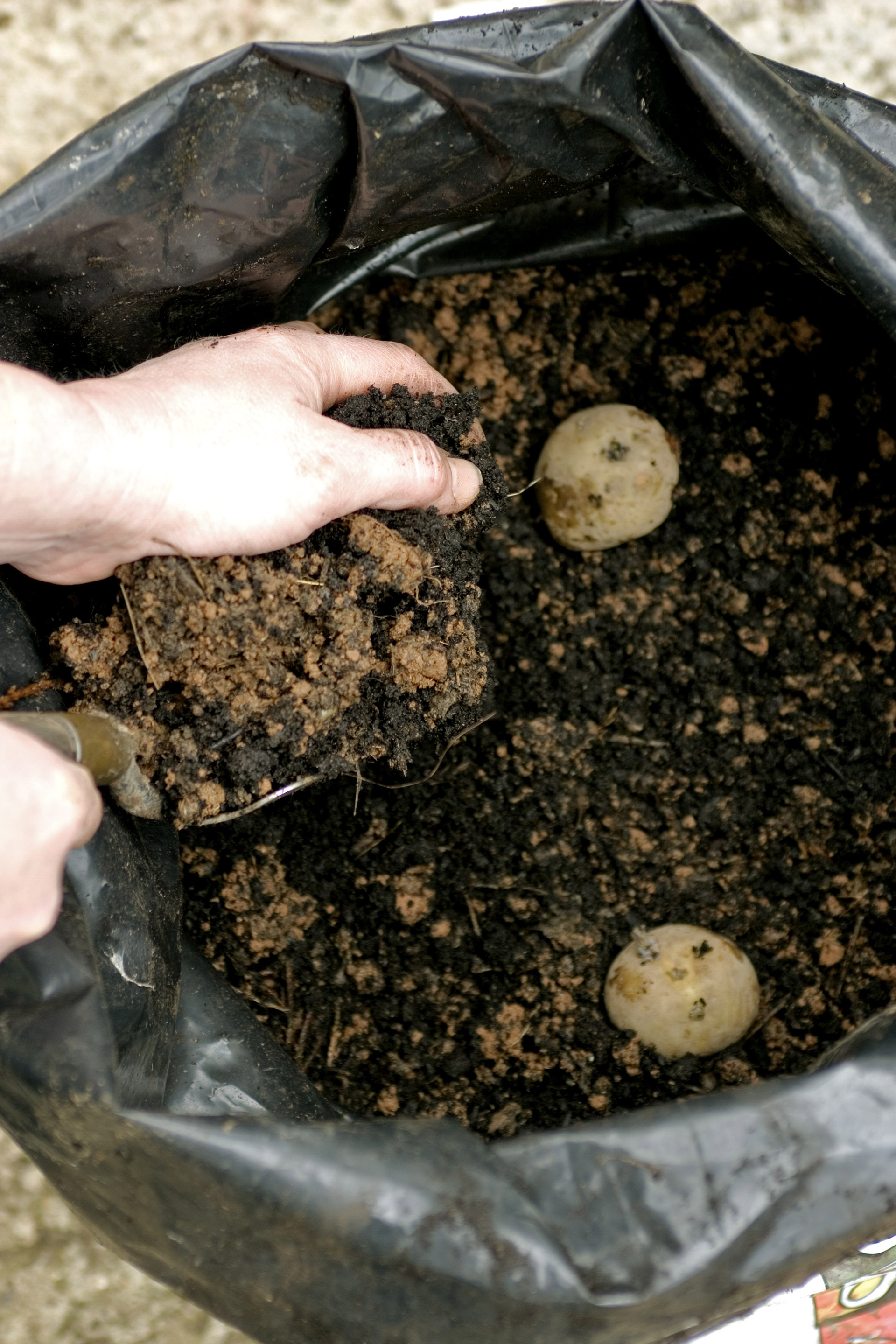
Quick and easy way to grow potatoes in a bag
If you would like a lower-maintenance method for learning how to grow potatoes in a bag then consider opting for this alternative method from Sue Sanderson, horticulturalist at Thompson & Morgan.
- Fill a two gallon potato or rubble bag (that has small drainage holes punched into the sides) with multipurpose compost to about an inch below the rim.
- Then plunge one chitted potato tuber 5 inches into the compost before covering with more compost.
- Place the bag in a bright, frost-free place, water and feed regularly and wait for the potatoes to grow.
- Let the potatoes continue to grow, rather than covering when the leaves appear, and then harvest potatoes in the same way as above when the leaves go yellow and limp.
- Be sure to store potatoes correctly to ensure their freshly harvested taste is retained.
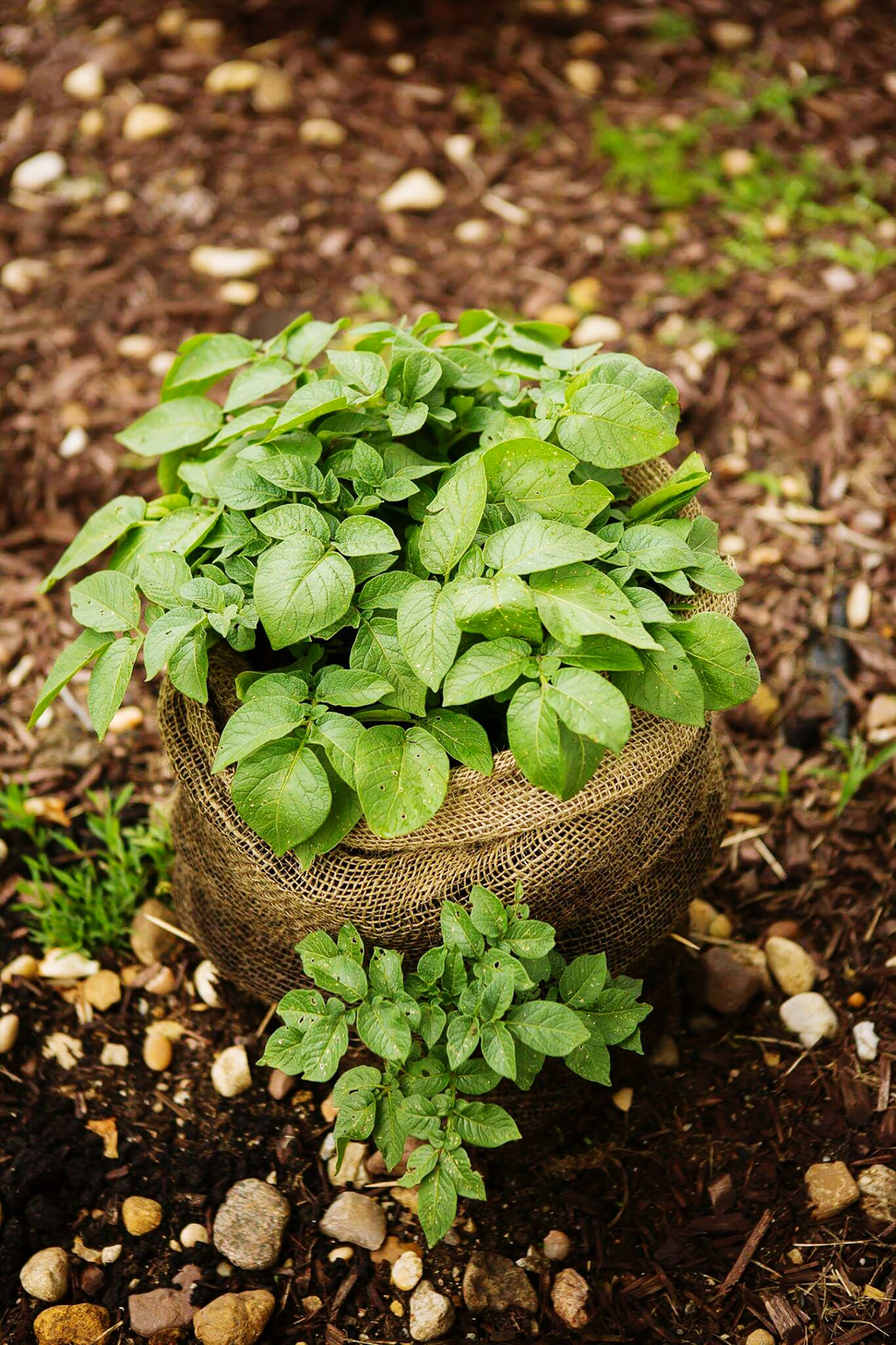
How to grow potatoes in a specific potato bag
While growing potatoes in a bag that you've repurposed is a great low-cost way to grow your own harvest of potatoes, a specialist potato grow bag can maximize the quantity and quality of your crop.
'As the roots grow and reach the side of the pot, the fabric causes the roots to stop growing, essentially killing the tips of the roots. This is called air pruning or root pruning. Roots that aren’t air pruned will instead continue to grow and circle around the containers, which leads to root-bound plants,' advises Deborah Miuccio, product research and testing coordinator at Gardener’s Supply Company.
'Air pruned plants encourage new roots to form from the center, which is the best root structure for container grown plants. A strong root system is essential for a bountiful harvest, especially for potatoes.'
You can even get grow bags that have a sealable pocket so you can check on potato growth and readiness.
If you opt to grow your potatoes in a specific potato bag, then you can follow which ever of the above methods works best for you.
How to grow potatoes in a bag sustainably
If you want to make sure that your method of growing potatoes in a bag is sustainable then there are a few things to consider.
Plastic sacks – like those used to sell compost - are a great option in which to grow potatoes. Reusing the bags in this way will recycle them and give them a life beyond their original usage. They will also still be able to reused for several years.
Hessian sacks or coffee bags can also be recycled and will even biodegrade when no longer usable.
Opting for organic potato seeds and avoiding the use of chemical fertilizers or pest-control will ensure that you produce a completely organic crop.
Finally, peat-free compost is a must. Peat compost contributes to greenhouse gas levels and its harvest eradicates the habitats of rare wildlife; there have been many calls to ban it due to the environmental cost. If you want to make your gardening even more sustainable, then you can use the compost from your compost heap. Our guide to how to make compost has helpful information on this.

How many potatoes does it take to grow in a potato bag?
It only takes one potato to grow in a potato bag. Each chitted potato - whether a whole potato or part of a larger potato – will produce one plant. The number of chitted potatoes needed depends on the size of the bag being used. As a general rule each potato plant needs about 2.5 gallons. Therefore a 10 gallon bag will support four potatoes while a 5 gallon bag will accommodate 2 potato plants.
If you want to grow a large number of potato crops, it is best growing them in separate bags rather than one huge bag. Splitting your crop between different bags means that you can harvest them at different times so you can have a more continuous supply, rather than a sudden glut.
How to grow potatoes in a bag in time for Christmas
'If you want to grow some potatoes in time for Christmas you best get to it, time is of the essence,' says Leslie Vincent, Horticulturalist & Gardening Expert at Atkins Garden Shop. Start planting your potatoes from mid-September to early October, for a December harvest. If you have your heart set on eating your own potatoes on Christmas Day, then stagger your planting – starting from the end of August through to the start of October.
Leslie takes you through the steps:
- 'Fill your bag with a decent multi-purpose compost about two thirds of the way full, lightly compact the compost.
- Lay three seed potato tubers on the surface, space them out around 20-30 cm apart
- From here, you’ll want to nicely soak your compost and give it adequate time to drain.
- If the watering has uncovered the tubers, add a bit more compost to cover.
- Place your bag in a greenhouse and wait for your shoots to appear, when they do throw in another layer of compost to keep them covered, repeat this process until the bag is full.
‘It's worth noting too that potatoes are cool weather crops and thrive best in the spring and fall, so if you miss planting them before Christmas, you can plan on planting them early and harvesting them for Easter,’ advises Shelby DeVore, animal expert, avid gardener and founder of Farminence.
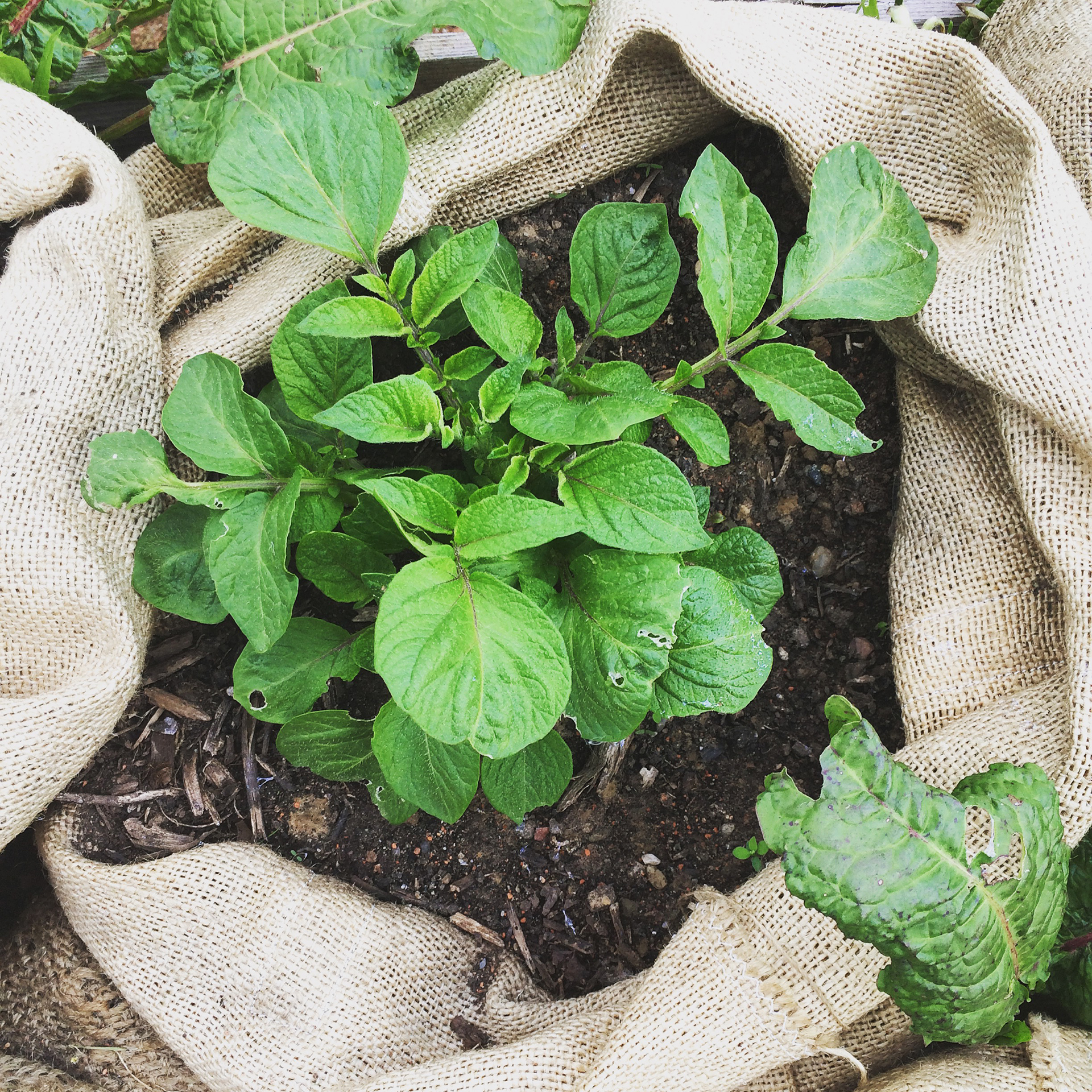
Now that you're clued up on how to grow potatoes in bags, if you have any issues with the growing process, be sure to explore our guide on potatoe growing problems and how to remedy the.

Having graduated with a first class degree in English Literature, Holly started her career as a features writer and sub-editor at Period Living magazine, Homes & Gardens' sister title. Working on Period Living brought with it insight into the complexities of owning and caring for period homes, from interior decorating through to choosing the right windows and the challenges of extending. This has led to a passion for traditional interiors, particularly the country-look. Writing for the Homes & Gardens website as a content editor, alongside regular features for Period Living and Country Homes & Interiors magazines, has enabled her to broaden her writing to incorporate her interests in gardening, wildlife and nature.